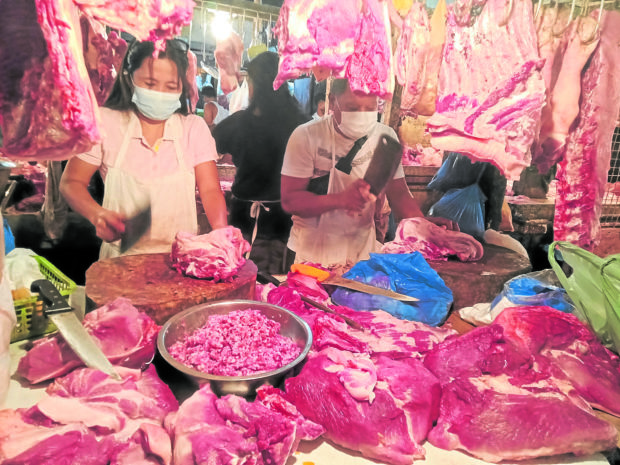Gov’t agrees to raise tariff on pork imports, reduce cap to 254,000MT – Sotto

FILE PHOTO: The price of pork has soared to P400 per kilo in Bulacan province early this year (2021) due to scarcity of supply after 60 percent of the province’s hog population was hit by the African swine fever. —CARMELA REYES-ESTROPE
MANILA, Philippines — The government has agreed to set the cap on imported pork products at 254,000 metric tons (MT) and slightly raise tariff rates on pork imports, Senate President Vicente “Tito” Sotto III disclosed on Wednesday.
The government initially planned to raise the minimum access volume (MAV) of imported pork to 404,000 MT from the current 54, 210 MT but this was strongly opposed by local hog raisers and many senators.
“Ang napag-agreehan namin is 254,000 metric tons (We agreed on 254,000 metric tons),” Sotto said in a phone interview after announcing that a compromise agreement was reached between the Senate and the executive department.
READ: Duterte favors increase in MAV for pork imports by 350,000 MT
He said the Senate wanted the pork imports cap at 200,000 MT only but the government made a counter offer.
“Nag compute si Sec. Sonny kung ano ang ok pa rin, mapagbibigyan ‘yung gusto natin at ‘yung gusto mga hog raisers, mga local producers pero hindi masasaktan ‘yung target nilang reduction in inflation,” the Senate leader explained, referring to Finance Secretary Carlos Dominguez III.
(Sec. Sonny made a computation which is acceptable to us, to local hog raisers without hurting their target reduction in inflation)
“So sa computation nila, kaya na ‘yung 254,000 MT (So in their computation, 254,000MT is doable),” he added.
Aside from reducing the cap on imported hogs, Sotto said the government also agreed to raise the tariff rates on pork imports.
READ: EO 128 to be amended as ‘compromise reached’ on pork import policies — Sotto
“Yung tariff tinaas ng konti,” he said. “Ang ibig sabihin hindi pwede ‘yung original nung EO 128.” (The tariff was slightly raised. Which means that the original EO 128 has to be amended.)
President Rodrigo Duterte signed last April 7 Executive Order No. 128, lowering tariff rates on fresh, chilled, or frozen pork meat “to address the existing pork supply shortage, stabilize prices of pork meat, and minimize inflation rates.”